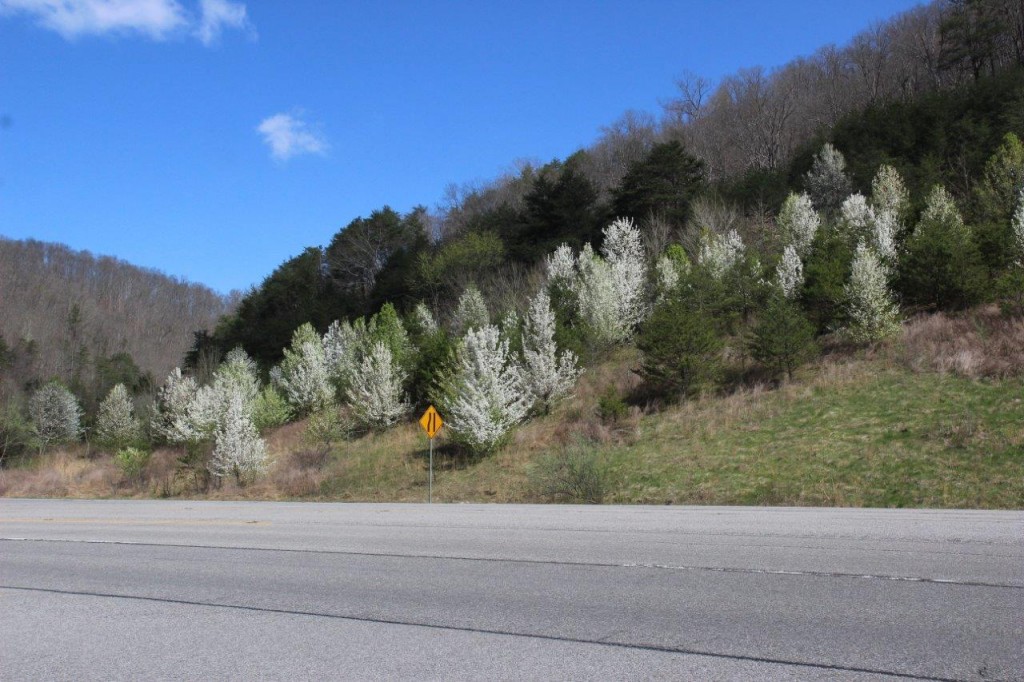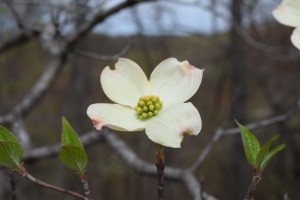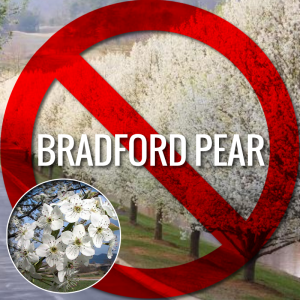“Just Say No” to Bradford Pear
Soon you will observe suburban yards dotted with and long driveways lined with densely flowered and branched Bradford pear trees. They create a breathtaking, yet malodorous, show each spring. Callery pear (Pyrus calleryana), of which Bradford pear is a cultivar, was introduced to the United States from China in the early 1900s, with the hope of improving the disease resistance of the common fruiting pear. It was admired for its symmetric shape and prolific flower production. The Bradford cultivar was widely planted as a promising new ornamental in the 1950s. A March, 2016 article in The New York Times reported that Lady Bird Johnson planted a Bradford pear in downtown Washington, D.C. to promote its use as a landscape tree. Its use quickly spread and Prince George County, Maryland, soon declared it the official county tree.
Concerns soon emerged over its structural weakness with limbs and whole trees breaking from wind, ice and snow. The Bradford pear was reported to be sterile. However, as new cultivars were developed to solve the structural problems, cross-pollination occurred and fruit was produced. Birds and other animals dined on the fruit and spread the seeds far and wide. Now we are faced with the Callery pear’s escape into natural areas, causing dense infestations in forest understories, rivaling that of Asian bush honeysuckle—much like Frankenstein’s monster, spliced together by man, wreaking havoc among the villagers. Callery pear is adapted to a wide variety of environmental conditions. It thrives in heavy clay soils, drought, heat and pollution. It grows best in full sun, but tolerates shade as well. This invasion can be seen locally in abandoned farm fields that have grown into a mishmash of bush honeysuckle, autumn or Russian olive and Callery pear. In addition, you’ll notice them along highway interchanges and right-of-ways.

Invasion of Bradford pear on a highway right-of-way in southern Illinois. Photo courtesy Chris Evans
What can be done? Removal in areas of Callery pear infestation is much the same as ridding our natural areas of Asian bush honeysuckle—cut and treat the stump with herbicide. This can be costly and requires manual labor. At the very least, we should stop planting it, plain and simple.
On a website for Indiana based Monroe County Identify and Reduce Invasive Species, a coalition of citizens aimed at reducing the environmental and economic impact of invasive species in their county through education and action, the author of an April, 2013 article put it bluntly. He said, “We still have time to stop this coming invasion. It’s simple. Don’t plant Callery pear in your yard. If it’s in your yard now, kill it. Replace it with a native flowering tree. Then tell your neighbors. Tell your local nursery that they should not sell this species. Tell that local strip mall with dozens of Callery pears that using this species in landscaping is hurting our forests.”
The University of Illinois Extension reports that the city of Champaign will no longer permit the planting of Callery pears on the city right-of-way. On their Facebook page, the Missouri Department of Conservation recently re-posted an article from April, 2017, whose title says it all—MDC ASKS PUBLIC NOT TO PLANT INVASIVE BRADFORD PEAR TREES.
“The best defense is a good offense” is an adage that has been applied to many fields of endeavor, including games and military combat. It is also known as the strategic offensive principle of war. We are, indeed, in war—a war on our natural areas. Let’s be on the offensive and, instead of planting Callery pear cultivars, plant species native to Illinois.

An alternative to Bradford pear is the native Flowering dogwood (Cornus florida). Photo courtesy Mike Fricke
If you have your heart set on a white spring-flowering tree, consider planting Serviceberry, also known as Shadbush (Amelanchier arborea), or Flowering Dogwood (Cornus florida). Serviceberry is the first native tree to burst into flower in the spring, usually March to April. The flowers are bright white, star-shaped and are produced in drooping clusters before the leaves appear. Flowering dogwood blooms in mid-April and May. The flowers consist of 4 large, white, petal-like bracts. Both species produce fruit enjoyed by wildlife.
For a little color, choose American Plum (Prunus americana) or Eastern Redbud (Cercis canadensis). The American Plum has 5 pinkish white petals on each perfect flower, appearing before or as the leaves begin to unfold. The fruit is sweet and reddish in color and favored by wildlife. Perhaps showiest in color, the Eastern Redbud flowers appear in clusters, sometimes emerging right out of the trunk. They are rose-purple in color and shaped like the flower of pea plants.
CLIFFTOP, a local nonprofit organization, is focused on preserving and protecting area blufflands.
A version of this article appeared in the April 6, 2018 issue of the Monroe County Independent.
© 2018 all content rights reserved Clifftop NFP
Comments are currently closed.

